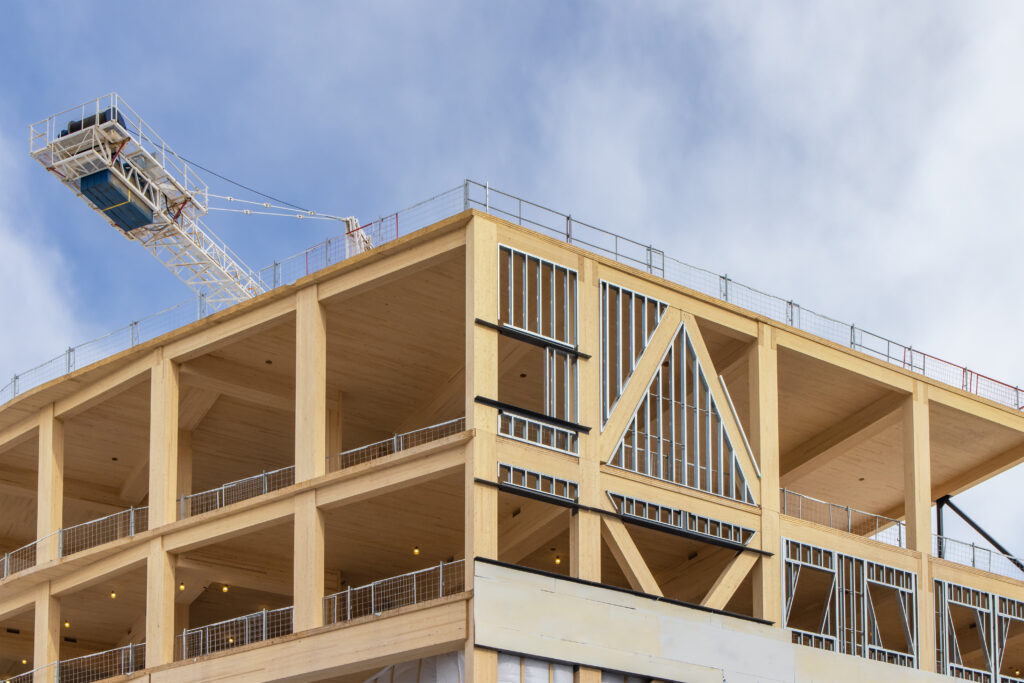THE FWD #226 • 501 Words
What is Mass Timber?
Mass timber refers to engineered wood products made by layering pieces of lumber together to create strong structural elements. Cross-laminated timber (CLT), the most common type, consists of layers of wood boards stacked in alternating directions and bonded with adhesives. This creates panels that are exceptionally strong, fire-resistant, and can replace concrete and steel in many buildings.
Opportunities for Virginia’s Affordable Housing
Construction costs are skyrocketing—but mass timber offers a potential solution. Research from WoodWorks shows mass timber construction can be 15-20% faster than traditional methods. Panels are prefabricated off-site and quickly assembled on location, reducing labor costs and construction time.
Environmental benefits extend beyond just the building itself. Virginia’s forestry industry, which according to the Virginia Department of Forestry contributes $21 billion annually to the state’s economy, could supply the timber while supporting rural communities. Mass timber buildings store carbon rather than produce emissions during construction, aligning with Virginia’s climate action goals.
The living environment for residents improves dramatically with wood construction. Studies published in the Journal of Environmental Psychology show that visible wood elements reduce stress and improve well-being—critical factors for housing stability.
Regulatory barriers are already coming down. Virginia adopted the 2018 International Building Code, which allows mass timber buildings up to 18 stories high, removing a major obstacle to implementation.
Challenges to Implementation
Initial investment costs remain a significant hurdle. While operational costs are lower, startup expenses for mass-timber manufacturing facilities and worker training require substantial capital. The U.S. Forest Service offers grants to help offset these costs, but competition is fierce.
Supply chain development in Virginia lags behind other regions. Currently, most CLT must be sourced from outside the state, with the nearest major producers located in North Carolina and South Carolina.
Knowledge gaps exist among building professionals. Many local architects, engineers, and contractors lack experience with mass timber systems, as highlighted in a recent Virginia Tech study on construction innovation.
Virginia’s climate presents unique challenges. Our humid environment requires careful detailing during design and construction to prevent moisture-related issues, according to the American Wood Council. (PDF)
Is Mass Timber Viable for Virginia’s Affordable Housing?
Yes, with strategic planning. Virginia does have four necessary ingredients for success:
- Abundant forest resources
- Growing demand for affordable housing
- Strong construction industry that could adapt to new methods
- Supportive building codes
Recent projects like the Apex Clean Energy headquarters in Charlottesville demonstrate that mass timber construction works in Virginia. For affordable housing specifically, pilot projects could showcase viability while building industry expertise.
As affordable housing stakeholders grapple with increasing costs from multiple directions, mass timber offers a promising alternative. It won’t solve Virginia’s affordable housing crisis overnight, but it represents an approach that aligns environmental sustainability with housing affordability and economic development objectives.
Window of opportunity? As the Trump administration pushes to increase U.S. timber production, an expanded mass timber industry may be a positive side effect. The challenge, ultimately, is whether Virginia’s housing industry can adapt quickly enough to leverage this potential opportunity.
